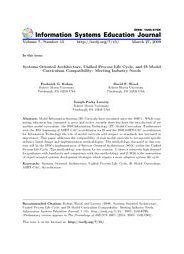Volume 7
Volume 7, Number 15 |
March 27, 2009 |
Abstract: Model Information Systems (IS) Curricula have circulated since the 1980’s . While computing education has continued to grow and evolve, recently there has been the introduction of yet another model curriculum-- the 2006 Information Technology (IT) Model Curriculum. Furthermore with the 2001 beginning of ABET-CAC accreditation for IS and the 2006 ABET-CAC accreditation for Information Technology the role of model curricula with respect to standards has increased in importance. This paper addresses the compatibility of such model curricula to incorporate specific industry based design and implementation methodologies. The methodology discussed in this context will be the IBM’s implementation of Services Oriented Architecture (SOA) within the Unified Process Life Cycle. This methodology was chosen for two reasons: 1) there is relatively high demand for graduates with familiarity and competence with this methodology, and 2) SOA is the maturation of object-oriented systems development strategies which require a more adaptive system life cycle.
Keywords: Systems Oriented Architecture, Unified Process Life Cycle, IS Model Curriculum, ABET-CAC, Accreditation
Download this issue: ISEDJ.7(15).Kohun.pdf (Adobe PDF, 9 pages, 417 K bytes)
Preview the contents: Kohun.j.txt (ASCII txt, 16 K bytes)
Recommended Citation: Kohun, Wood, and Laverty (2009). Systems Oriented Architecture, Unified Process Life Cycle, and IS Model Curriculum Compatibility: Meeting Industry Needs. Information Systems Education Journal, 7 (15). http://isedj.org/7/15/. ISSN: 1545-679X. (A preliminary version appears in The Proceedings of ISECON 2007: §2314. ISSN: 1542-7382.)
